Hammers: features, types and their purpose
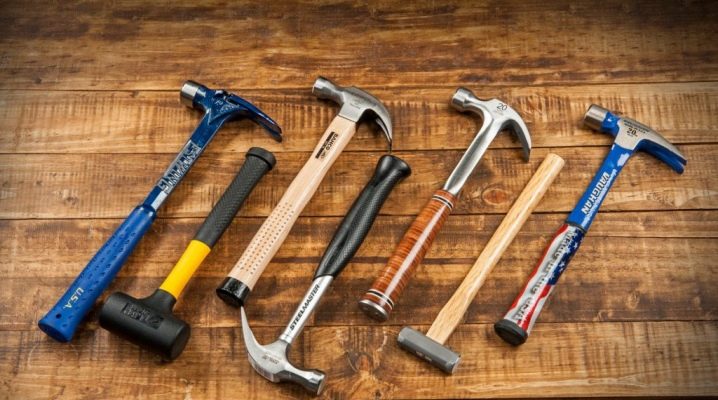
The hammer is one of the most ancient tools of labor; it has found universal application in many types of economic activities. In Soviet times, it was part of the state symbol, expressing the essence of productive labor. What this tool is, what kinds of it exist - we will tell you in this article.
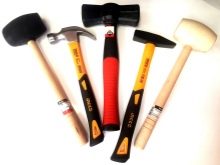

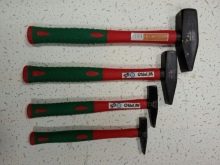
What it is?
With a hammer, you can not only hammer in nails or break objects, but also bend, level, smooth, and so on. The tool is used in a variety of ways. This is not only construction and repair, but also medicine, welding, shoe making and the like. The hammer combines impact capabilities, depending on the weight of the product and the muscular strength of a person, with a fairly small size. Allows you to amplify the impact while maintaining accuracy. Converts kinetic energy into a concrete result of mechanical work.
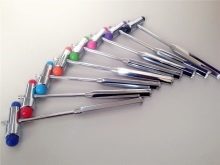
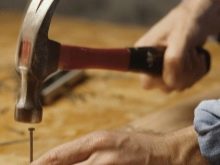

The manufacturing technology of the contact surface of the tool from metal provides for different methods of hardening. The side used for blows is hardened in water, for pulling out nails in oil. The former provides strength, the latter provides flexibility. A special coating is applied to reduce the risk of corrosion. The handle must meet the following requirements: strength and lightness combined with the required length. A variety of nails require the use of tools of the appropriate size and weight. The larger the nails, the heavier the tool.
Even such a simple technique as a hammer blow has various options. Precision is achieved with short hand movements. Impact of medium force is produced by action "from the elbow". The most powerful, but least accurate blows are delivered with a swing of the shoulder.
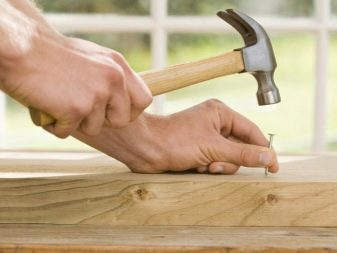

What does it consist of?
The construction of this production tool is quite simple. The main components are a handle and an impact attachment (head), which is made of steel. As a rule, from different sides it is not the same in shape. One side along the edges is flat, called a striker, the other has a sharpness (wedge) or the so-called "dovetail" used to pull out nails. The hammer usually hammers, and the wedge-shaped side splits, the "tail" is used as a nailer.
Some add an attachment point to the design. It is a small element that provides a secure and solid connection between the handle and the head. In the most ordinary version, it is a special metal wedge (of various shapes), which is hammered in such a way that the handle expands as much as possible. The wedge-shaped part of the striker transmits the force to a minimum area, which provides more effective breaking or is used in some versions in the embossing process. The hardened steel striker must be very “tough” and withstand a lot of intense impacts. In cross-sectional shape, it is round, square and rectangular.



The head is protected from corrosion with a special paint, if it is made of copper, titanium or wood, the coating is not applied. The handle is made of hard wood, plastic or metal, with a special rubber coating that prevents slipping in the hand and is resistant to moisture. The length of the handle depends on the weight of the product. On average, it does not exceed 32 centimeters, for heavy hammers - 45 cm.The cone-shaped end is designed to prevent separation of parts at the junction.
Wood for the manufacture of the handle is used in the classic case. In this option, wooden parts made of hard or flexible species are recommended, without knots, pine, spruce or alder are definitely not suitable here. The surface must be dry and free from external defects. The use of a wooden handle automatically implies the need for a wedge, which will prevent the bit from jumping off. The fibers of the part on which the striker is mounted should run along, and not across, as this significantly reduces the risk of injury in the event of a breakdown. In addition to wood, metals coated with rubber materials or various plastics are also used here.


Types and their purpose
The types of tools differ in design depending on the specific purpose of the product. Types and sizes, weights are clearly described in GOST 11042 - 90. Each type has specific areas of application. The small tile hammer is not a pickaxe. Handles and attachments, weights and sizes are very diverse, shapes also differ. In the event that it is necessary to prevent rebound, the impact hollow part is filled with sand or shot.
There are specimens with a fiberglass handle. This material is relatively new and has shown itself to be excellent in service. Such a tool does not slip in the hand and reduces recoil, increasing the efficiency. The aluminum element in the design is also quite attractive, however, it is significantly inferior to fiberglass in strength.


The all-metal option is another technological solution. It is used in products used in welding, knocks down scale with small strong hammers. The handles of metal hammers are made hollow and covered with rubber. In all cases, the striking part should be significantly heavier than the handle.
The construction hammer has two very strong impact parts. The first is in a square cross-section, of a classic look, the second is a flattened flat wedge, the use of which is very effective in fracture. The design is complemented by a long oval handle. The nailer is a common design solution for woodworking.
It is known that wooden elements "love" various fastening parts, which often have to be disposed of in the process of solving problems.



The good thing about the copper hammer is that it does not generate sparks from impacts. The main purpose is application at explosive objects. The copper-plated assembly tool is resistant to corrosion, is considered a friend of the installer in very low temperatures, since it does not lose its strength properties. It is very relevant in industries directly or indirectly related to the production and transportation of oil and gas.
The large kinetic inertial hammer is designed to absorb the inertia of impacts. This is achieved through the use of heavy rolling parts - balls in a hollow cylinder. Physical laws and practical mechanics work here, the balls, moving, act as an "absorber of inertia". In case of urgent need, such a product can be made with your own hands. This will require a sturdy wooden handle, a piece of pipe of the correct length, shape and diameter, and lead shot used for hunting. The shot is placed inside a T-shaped tube closed on both sides, the handle is firmly fixed in the open part of the part.
Attention should be paid to the reliability of the connection between the pipe and the wooden handle.


The riveting hammer is an automatic hammer action equipment. It connects different elements into one whole with rivets. The drive in the device can be electric, pneumatic or hydraulic. The total weight does not exceed 4 kilograms.In fact, this is an automatic machine, which, due to the drive, carries out serial shock movements, riveting various elements.
Fizdel's hammer is another rather curious device, weighing only 0.25 kg. Serves to determine the degree of strength of "fresh" concrete by checking its resistance to deformation. A small steel ball is used here as a striker, and it is intended for striking. The strength of the still rather soft concrete is determined by the size of the imprint on the ball, of course, this estimate is approximate and approximate.


Plotnitsky
A characteristic feature of this option is that the nails should be "friends" with the magnet. The flat firing pin is magnetized to hold the element to be driven. The surface of the striking part is smooth or corrugated. The bifurcated end of the other side of the metal attachment ensures that the nails are pulled out. Weight does not exceed 0.8 kg. Small nails will need a tool weighing up to 0.3 kg, medium - 0.45 kg. The operation of hammering in large nails from "weaving" (10 cm) and above will require a tool weighing at least 0.65 kg.


Joiner
The carpentry hammer also provides a tool used to pull the nails out. This increases the overall efficiency of the work, because the use of tongs is not required. Alternatively, the second side of the striker is made in the form of a wedge. Here is a different purpose, not pulling out, but striking.
The main task of using this tool is not so much punching due to muscular strength, but accuracy. As usual, a variety of materials are used to make the pen.


Locksmith
This hammer is considered to be the most common hammer. Scores and straightens well. Should help to work on metal, hammer in nails and other fasteners. Has two different sides of the striking part, flat and tapered. The narrow side is used when specific conditions require it, for example, the size of the nails or the place where the blow is made. The contact part of the flat side can have not only a square, but also a circular cross section.
In all variants, the material must be resistant to deformation. The handle is designed to combine reliability and convenience. Available in various versions.


For stone
When working on stone, a mallet made of wood is usually used. The two sides of her drummer are exactly the same in shape. Copper or rubber can be used to deliver softer impacts and prevent critical damage to the material being laid. A pick or pick is a different tool of masons. They can successfully work on brick or stone, both during dismantling and laying. In the course of the working process, the element to be laid is fixed, the second part of the nozzle is used to break up old plaster, clean surfaces from unnecessary dry materials or split the laid products to the required dimensions.


A pick for its manufacture requires strong steel of excellent quality. Fiberglass for the handle is an excellent solution, otherwise a rubber coating is used, which can reduce vibration and prevent hands from slipping in high humidity conditions. A sledgehammer is another option widely used in construction and repair work. In principle, it does not differ from a mallet in shape, but significantly exceeds in weight. Serves for driving pillars, elements of strong structures and destruction in the process of major repairs. Requires significant effort.
The total mass of such a tool starts from 2 kilograms and can reach 16 kg. Absolute hitting accuracy for this tool is not required, but the strength of the user is extremely necessary. It is not recommended to make a sledgehammer with your own hands from scrap materials, since you need a drummer made of very durable materials. As a rule, the striking part of the sledgehammer is a heavy steel parallelepiped.The handle must be capable of striking with both hands. The tapered end is designed to prevent the head from slipping.
The use of a rubberized cover or fiberglass makes the sledgehammer more comfortable and therefore potentially safer. Experts warn against using this percussion weapon with extreme caution, as there are risks of serious injury from reckless actions.


When laying paving slabs, a bricklayer's hammer is in demand. One part of its striker is flat with a square section, the other is pointed. The hardened tool steel of the striker must meet increased strength requirements, wood or more expensive materials are suitable for the handle. The weight is small. The handle is sometimes made with ruler marks, as this helps the user in his work.
In general, such an instrument combines percussive capabilities with "dot splitting". In this type of economic activity, a mallet is also in demand, with the only difference that it does not prick, but only knocks and straightens. Each specialist works the way he is comfortable with and with the tools that suit him the most.


Roofing
The roofer's tool is underlined by the name, since it is used in the corresponding type of activity. The main requirement for the striker is the impact force tolerance for roofing materials. The round shape of the striking part and the claw are essential attributes, just like a carpenter's hammer. Weight - no more than 0.6 kg. When purchasing such a product, the first step is to pay attention to the quality of the steel. The alloy with chromium and vanadium elements is praised because of its positive impact on production results.
In unsatisfactory quality, the material of the tool under heavy loads may bend or crack. The nail pulling device will not be able to perform its function. A very soft metal is a marriage. It is especially unpleasant to get such a copy when working with large nails. In some variations, the roofer's hammer combines a groove used to bait the nail and a magnet that helps hold the nail in place without using both hands. The spout of the second side of the nozzle is very sharp, which allows punching slate and other roofing materials. The rounded handle provides a comfortable grip.

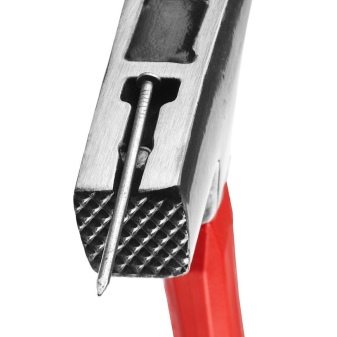
Tiled
This type of hammer is characterized by its very small dimensions. Weight no more than 80 grams, purpose - to help in laying tiles. Large weight is contraindicated, since it will only create the risk of marriage with excessive stress. For the owner of expensive tiles, this is sensitive. A striker is set on a wooden handle, in one side of a square section, in the other - in the form of a cone. Punches holes and helps to fix tile elements, the main principle of use is precision and accuracy.


Straightening
Mallets are used for straightening fragile or soft material, the striking part is made of rubber or wood. Good for automotive repair operations when restoring body parts. The main purpose is alignment. "Tinsmith's Day" comes due to weather conditions and traffic results, when there is a lot of work for specialists to use this product. A mallet hammer is a cylinder or "barrel" made of rubber, polymer, or not very hard metal. The shot is used to fill the inner cavity, which dampens inertia and excludes rebound. The material of the striking part should not leave traces of a different color on the surface of the plane to be leveled.
If wood is used, then it is usually birch. For "delicate" operations, rubber pads are put on the firing pin. As a rule, handles with round cross-section are made of plastic or wood, and much less often - metal.
For accurate blows, a product is not too large and weight, for a strong impact, on the contrary, a specimen weighing about 1 kilogram is required.


How to choose?
Even in such a matter as choosing a hammer, care is required. The main question of the buyer is the purpose, which is precisely determined by the design of the drummer. Before you take this or that option into your home set of tools, you need to make a thorough examination of it. The shank should have a high-quality appearance and a smooth surface without cracks. If rubber is used as a backing, make sure that there are no swollen areas.
An important question when choosing is the comfort of the grip. The connection between the striker and the handle must be free from defects and gaps. Damage or deep scratches to the head indicate the low quality of the metal used. If the product is purchased for home use, its weight should not exceed 0.45 kg. For more serious repair and construction manipulations, a hammer with a mass of at least 0.65 kg is required.
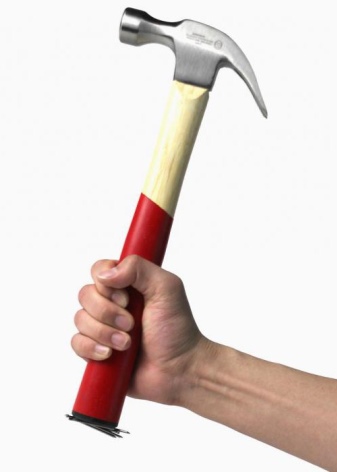

Sometimes there are times when the owner does not want to part with a reliable, well-tested part of his collection after the occurrence of a defect in the handle or its breakage due to work experience. In principle, the problem of buying or manufacturing it can be solved independently. A handle made of oak, birch or other non-fragile wood species can be purchased ready-made or made on industrial equipment. Then, if necessary, it is sanded with sandpaper on its own.

Safety at work
Before starting the workflow, the first step is to make sure that it is reliable. Defects and cracks, backlash of the striking part are strictly not allowed. The first blow is always trial, the swing is small. If the surface is not too hard, you do not need to apply excessive force. The blow to the nail is carried out in the center, the gaze is directed to the point of application.
In the event that you need to hit very hard, the hand works from the shoulder, and not just from the elbow. The lightest and most accurate actions are carried out with wrist movements. If the material is chipped, the eyes must be protected with goggles. It is advisable not to hold small thin nails, but to stick them in.
Working with metal sheets requires the use of thin pads on a wooden base. The point of their use is to fix and prevent displacement. Gripping closer to the impact attachment can slightly increase accuracy, but will reduce the impact force. Everything must be well timed before striking.
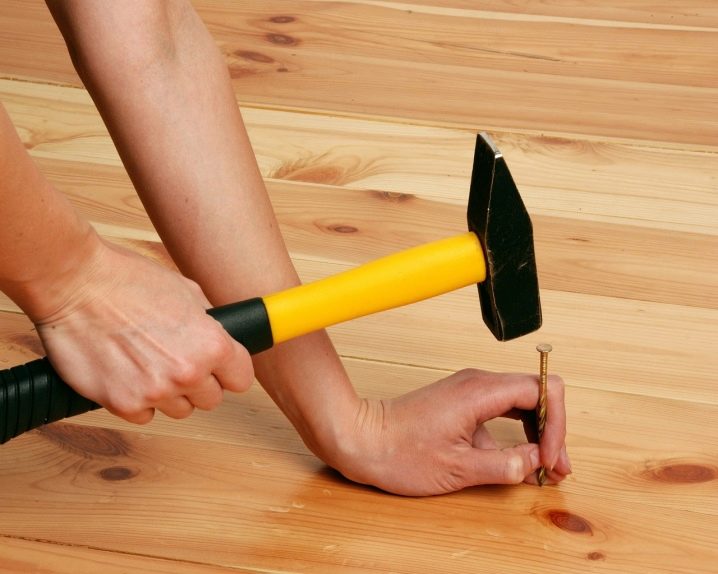
The power depends on the weight of the tool, the physical condition of the worker and his practical skills. The most common hammer injury is finger injury. The correct technique for any type of hammer is to be in a natural position when striking and to hold the handle by the base, not the middle. Practice will correct these movements, however, in any case, you should be careful not to harm yourself and others.
When hammering, you should not use a handle as a striking part, if only because this will significantly reduce its service life. In addition, if it breaks, there is a high likelihood of injury. When hammering in nails, it should be clearly understood at what angle they should enter the object. The harder the surface, the greater the impact force. The sharpness of the swing and precision ensure the success of the operation. The striker hits the center of the nail head, not the edge.
Even with the simplest operations, we must not forget about the danger of injury, therefore we carefully take care of our fingers, eyes and heads. Ours and others. We only use a hard surface as a basis for our "desktop work".


For more information on hammers, see the next video.













The comment was sent successfully.